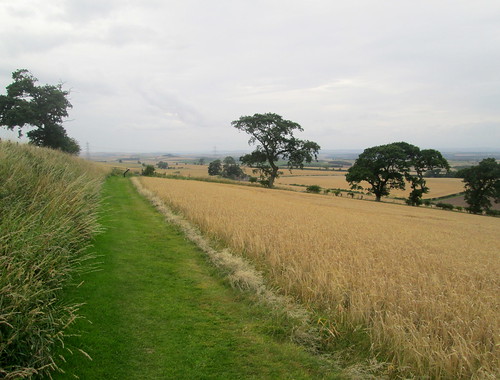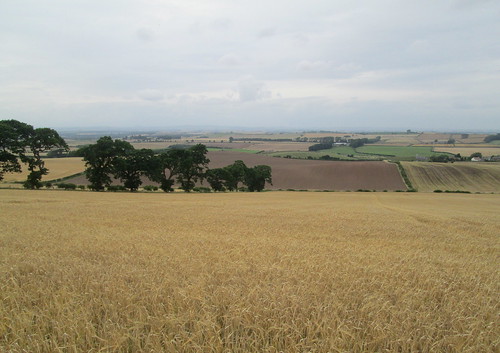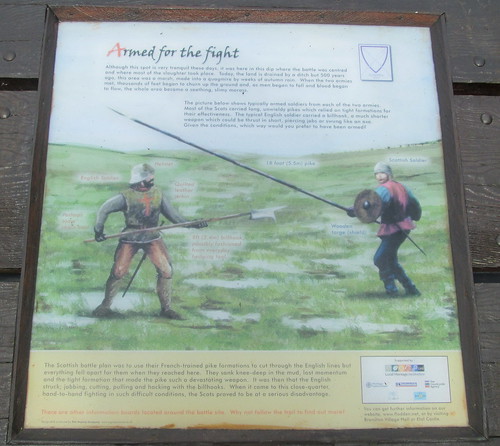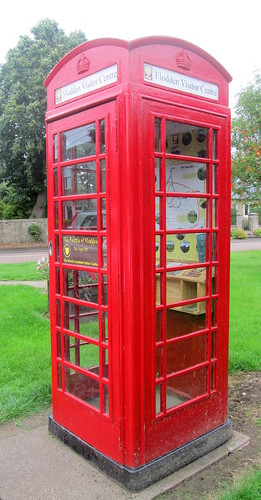Flodden
Posted in Scotland, War Memorials, History at 01:00 on 9 September 2013
Today is the 500th anniversary of the most disastrous encounter between the forces of Scotland and England in history. (Bigger even than the 9-3 reverse at Wembley only 50 years ago. But that was a mere football match.)
On the 9th Sep 1513 14,000 men died on a battlefield in Northumbria. 10,000 of those were Scots – including most of the Scottish nobility and even the King, James IV, himself, the last British king to die in battle. The Battle of Flodden Field was at one and the same time the biggest clash of arms between the two countries plus it was the last mediæval and first modern battle on British soil. Never again was the longbow to be a major weapon, never before had artillery been employed.
My memories of reading about this were that it was an unnecessary tragedy as James had only invaded Northumbria as a sop to the Auld Alliance between Scotland and France. England’s king, Henry VIII had gone to war with France and Louis XII had appealed to the Scots king. One of the peculiarities of this situation is that James’s wife was Henry’s sister, Margaret. She had apparently asked him merely to “break a lance” to honour his obligations. I doubt that she thought he would not return.
Reading the BBC History magazine a couple of weeks ago it turns out that Henry VIII’s father, Henry VII, aware of his tenuous right to the English throne had foregone the English claim to Scotland and signed the Treaty of Perpetual Peace. Henry VIII had no such inhibitions – or else was eager to bolster his own position – and had recently reasserted England’s overlordship over Scotland. James, then, in effect, had no option but to stand up to Henry.
His initial efforts were successful, taking three castles in short order. He then set up a strong fortified position on Flodden Hill and awaited the English forces. The English commander, Thomas Howard, Earl of Surrey, apparently accepted battle on James’s chosen ground. However, being out of favour with Henry, he was desperate for a victory and instead of attacking at Flodden Hill, he made a flanking manœuvre, interposing his army between the Scots and the border. James was furious at this unchivalric behaviour and had to make a quick redeployment to Branxton Hill instead. Perhaps it was this anger that led to his lack of judgement in the battle. Wikipedia has the details of this dispute over the proposed battleground slightly differently.
The plaque reads, “Flodden 1513. To the Brave of Both Nations.”
The Scots artillery was heavier but more cumbersome and so less effective but at the beginning of the battle the Scots left completely overran the English right (if only!) and retired from the battlefield expecting the rest of the army to achieve overall victory. In the centre, however, things did not go so well. From their position on Branxton Hill the Scots could not see the boggy ground in the declivity between the lines.
Flodden Memorial. View to Branxton Hill. From English start line.
Flodden Memorial from Scottish line. Memorial is just left of centre here.

The Scottish start line at Flodden.
The Scots infantry, armed with long pikes, whose efficiency had been proved in European battles, soon lost the essential formation necessary for success as they slipped and slid on the uncertain footing. The pikes also could not be anchored securely due to the underground conditions so were useless defensively. The English infantry, armed with much shorter billhooks, waded in to bloody effect. Dead bodies and blood soon made the conditions even worse.
To their credit, as one of the information boards on the Battlefield Trail says, the Scots did not cut and run, but bravely fought on.
The memorial, built in 1910, is inscribed to the brave of both nations. I have been told the only other battle memorial to acknowledge both armies is at Quebec but cannot confirm this.
There is an information centre – in a red telephone booth – in Branxton village. It claims to be the smallest information centre in the world.
James had been making his court and kingdom one of the most cultured in Europe, and Scots into a major European language. That process came to an abrupt end on his death.
The result of the battle at Flodden, the subsequent decline of Scotland’s influence, is probably the main reason why this post is being written in English rather than Scots.
The irony is that, despite the result of the battle, it was not Henry VIII’s descendants that would unify the crowns of Scotland and England and be monarchs of the UK but rather James’s, through his marriage to Margaret, their son James V and granddaughter Mary Queen of Scots, down to her son James VI and I.
The disaster is said to have inspired the traditional Scottish lament for the fallen, Floo’ers o’ the Forest,” sung here as The Flowers o’ the Forest by Isla St Clair.






